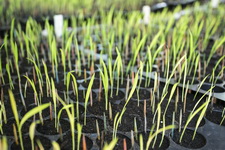
Study Reveals Plant Sugar Transporter Involved in Carbon Sequestration
October 21, 2015| |
 Two research teams led by Wolf Frommer at the Carnegie Institution for Science have identified sugar transport proteins which play key roles in various plant processes.
Two research teams led by Wolf Frommer at the Carnegie Institution for Science have identified sugar transport proteins which play key roles in various plant processes.
The first research team, led by Liang Feng from Stanford University School of Medicine unravelled the molecular structure of a SWEET2 transporter from rice. Discovering the structure of SWEET2, and determining the key amino acids in the protein necessary for function, is the key to understanding how it works, and what happens when the transporter fails due to disease or pathogens. The other research team, on which Frommer worked with Woei-Jiun Guo and Dorothea Tholl of Virginia Tech, focused on SWEET2's role in protecting Arabidopsis from parasitic infection. They showed that SWEET2 helps stockpile sugars in the vacuole, thereby limiting the sugar supply to feed only the good microbes and prevent the growth of the bad ones.
The team showed that SWEET2 facilitates the retention of sugar in the roots, which could starve and resist pathogens living in the immediate root surroundings. They found that SWEET2 expression increased 10-fold during parasite infection and that specially created mutants lacking SWEET2 were more susceptible to the parasite. Frommer said, "Together, these two papers provide first insights not only into how plants control carbon sequestration into the soil, but also improve our understanding of the functioning of this unique class of SWEET transporters."
For more details, read the news release from Carnegie.
| |
Biotech Updates is a weekly newsletter of ISAAA, a not-for-profit organization. It is distributed for free to over 22,000 subscribers worldwide to inform them about the key developments in biosciences, especially in biotechnology. Your support will help us in our mission to feed the world with knowledge. You can help by donating as little as $10.
-
See more articles:
-
News from Around the World
- World Food Day Celebration Highlights Social Protection and Agriculture
- 12 New Whole Genomes of Viruses Affecting Cassava Discovered
- Study Reveals Plant Sugar Transporter Involved in Carbon Sequestration
- BRRI Scientists Set for Confined Field Trials of Golden Rice
- Scientists Shed Light on Molecular Mechanisms of Bacterial Plant Disease
- Gene from Bacteria Helps Plants Use Hardly Digestible Organic Phosphorous
-
Research Highlights
- Wheat Resistance Gene Lr34 Confers Partial Blast Resistance in Rice
- Red Light-Mediated Degradation of CONSTANS Regulates Photoperiodic Flowering in Arabidopsis
- Interaction of ERF3 and WOX11 Promotes Crown Root Development in Rice
- TaGS5-3A Gene in Wheat Regulates Grain Size and Yield
-
Beyond Crop Biotech
- Genes Involved in Response to Chlamydia Infection in Koalas Identified
- Researchers Develop Bacon-flavored Superfood Seaweed
-
Announcements
- International Conference on Protein Engineering
-
Resources
- Bringing Biotech to Life: An Educational Resource
- Infographic: Biotech Foods are Safe
-
Read the latest: - Biotech Updates (April 24, 2024)
- Gene Editing Supplement (April 24, 2024)
- Gene Drive Supplement (February 22, 2023)
-
Subscribe to BU: - Share
- Tweet
